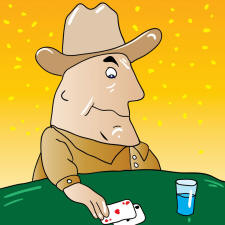Reading Up Cards in Seven Card Stud
 Your opponents’ up cards are your greatest source of information in Seven Card Stud. Out of the seven cards each opponent receives, you will get to see four of those cards. When you combine that information with your opponents’ betting patterns, you can narrow down their range of hands to a manageable number. From that point, you can then decide on the most profitable action on each street.
Your opponents’ up cards are your greatest source of information in Seven Card Stud. Out of the seven cards each opponent receives, you will get to see four of those cards. When you combine that information with your opponents’ betting patterns, you can narrow down their range of hands to a manageable number. From that point, you can then decide on the most profitable action on each street.
The flow of information in Seven Card Stud starts out as a trickle and then increases to a flood as the hand progresses. On third street, you only get to see one of each player’s cards and you only get to see one bet. As you progress through each street, though, you get to see additional cards and more bets. It’s like watching a Polaroid picture develop right before your eyes.
Third Street
On third street, your information is severely limited. That’s why it’s important for you to stick with strong starting hands. You really have no idea what each player has. In fact, nobody knows what they will have by the time the seventh card is dealt. The best you can do on third street is notice which opponents have the highest up cards and which opponents seem the happiest to bet.
Fourth Street
Fourth street basically doubles the amount of information you have access to. You get to see an additional card and an additional bet from each player. At this point, you can start to see patterns develop. Notice the players with suited cards who are just calling. There’s a good chance those players are on draws. The players with big cards who are betting might have big pairs. The players with small pairs might even have trips.
At this point, these are all just educated guesses. Each player has two hidden cards so the guy with the two suited cards might be hiding a pair of aces or even three of a kind. The guy who’s betting with a low pair showing might just be bluffing. You have to be ready to change your analysis as soon as more information is revealed.
Fifth Street
Fifth street is the first street in which your opponents’ up cards outnumber their hidden cards. This is also the first street where the big hands (flushes, straights and full houses) are possible. Keep an eye out for players who have coordinated boards and are not folding. They could already have something or they may be drawing to something big.
Sixth Street
There are now twice as many up cards as down cards and your information is at an all time high. You should have a pretty good idea of what the remaining players have. There is a reason they have stuck it out this far in the hand: they believe there is a good chance they will win the pot. It could be because they have a real hand or because they have a strong draw.
Sixth street is also where people tend to stop slow playing. If someone has a strong hand and they decide to slow play it, they will usually slow play it on the early streets, give the players on fifth street a chance to catch up and then start jamming it in on sixth street. This is the second-to-last betting round so the players with real hands want to start getting money in the middle.
Seventh Street
The only additional information you gain in seventh street is what you glean from your opponents’ bets. The last card is dealt face down so you will have to rely on your opponents’ existing board cards and their betting patterns up to this point. Generally, the deception all ends on seventh street. The players with real hands are making their bets and the players with weak hands are getting the heck out of the way.
You’ll run into the occasional bluff on seventh street but people don’t bluff the river in Seven Card Stud as often as they do in Texas Hold'em. It’s difficult to get away with bluffs on the river because so many cards are showing and because the bets are so small compared to the size of the pot.
Cross Connecting Board Cards
One additional piece of information that might help you in your hand reading is to notice how some of your opponents’ up cards affect the likelihood of your other opponents having certain hands. What I mean is, if it looks like someone has a flush but you can see five spades showing on other players’ boards (including your own), the odds of that player actually having the flush are lower.
This is not an end all solution to hand reading, of course. It’s just one more piece of information and one more way for you to look at the game. To succeed in Seven Card Stud, you must be able to look at the game from the eyes of your opponents. An ability to think outside the box will help you see things that other players miss.
